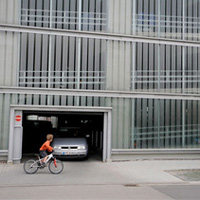Envisioning Parking Strategies in the Framework of Sustainable Urban Transport
Abstract
Monetary instruments to regulate parking are often used in central areas of cities to discourage long term parking of vehicles. The availability of parking facilities, and its cost, in fact represents an important element in the decision to operate private vehicles in urban areas. The availability of instruments and tools to check the outcome of modification in parking regulations, in terms of modification of car use, successfully support planners in the determination of the best policies to decrease congestion, and regulate the use of transportation in cities. Integrated land use transportation models may successfully contribute to the assessment of such policy packages. This contribution discusses the use of the model MARS-Bari (Metropolitan Activity Relocation Simulator) for the analysis of future scenarios of development of land use and transportation. MARS-Bari is a fast integrated land use transportation model, which is designed for applications in strategic planning of urban and metropolitan areas. The model was developed as a decision support tool, to help planners in the definition of sets of policies on land use and transportation, and promote equilibrated growth of the urban system (smart growth). MARS-Bari shares the basic assumptions of the Metropolitan Activity Relocation Simulator (MARS) modeling system, so far successfully applied to many cities of both Europe and Asia. The structure of MARS-Bari is highly flexible on purpose, allowing multiple hypothesis tests of future scenarios and policies. MARS-Bari works at a high level of spatial aggregation, and its simulations are developed on a long-term time horizon (30-years in the current version). Two main sub-models run in MARS-Bari: they respectively simulate the development of land use, and the transportation system. Four different classes of users are distinguished in the transportation model, depending on the possible access to one or more of the five transportation modes: car, motorcycle, bus, train, and slow mode (walk and bike). Car and motorcycle ownership and availability functions contribute to the definition of travel patterns and activity participation of users, in dependence of the chosen residential location and of the location of the economic activities. The model was implemented and tested on the metropolitan area of Bari, Italy. MARS-Bari allows the evaluation of different scenarios of future development of the area, predicting the expected outcomes of policies and interventions on land use development, transportation infrastructures, modifications in the local economy, financial regulations and fares (e.g. fuel price, road pricing, congestion charge, parking fares, etc.). The estimation of indicators for environmental quality and pollutant emissions from transportation permits the direct comparison of the outcomes of different scenarios, thus supporting the definition of sets of “second-best” choices for policies in both land use and transportation planning.Downloads

Copyright (c) 2014 Tema. Journal of Land Use, Mobility and Environment

This work is licensed under a Creative Commons Attribution 4.0 International License.
Authors who publish in this journal agree to the following:
1. Authors retain the rights to their work and give in to the journal the right of first publication of the work simultaneously licensed under a Creative Commons License - Attribution that allows others to share the work indicating the authorship and the initial publication in this journal.
2. Authors can adhere to other agreements of non-exclusive license for the distribution of the published version of the work (ex. To deposit it in an institutional repository or to publish it in a monography), provided to indicate that the document was first published in this journal.
3. Authors can distribute their work online (ex. In institutional repositories or in their website) prior to and during the submission process, as it can lead to productive exchanges and it can increase the quotations of the published work (See The Effect of Open Access)
